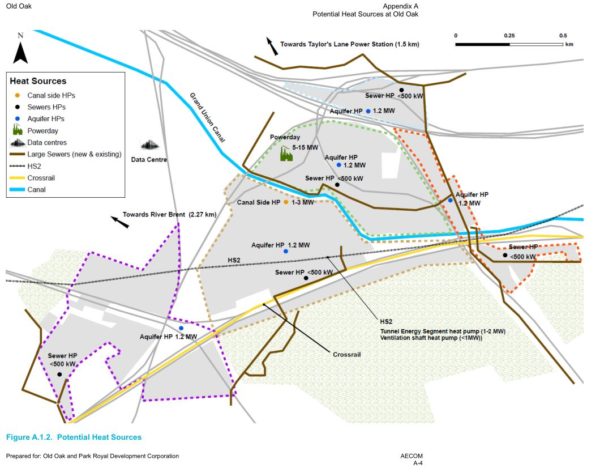The heat from train tunnels at Old Oak Common could be used to heat water and power central heating of up to 500 new homes that are to be built near the HS2 station.
The scheme would see 5 air source heat pumps draw warm air from HS2’s railway’s tunnels, where the waste heat from trains is usually extracted by traditional ventilation systems and seeps into the ground surrounding the tunnels.
The placement of the heat pumps would be in the large crossover box where trains will be able to swap between lines. The crossover boxes tend to be vast spaces, which should make them ideal for the additional equipment to be installed, although in this situation, the crossover box is outside the main development site, so there will be some loss in transferring the warm air to the new housing estate.
The waste heat would then be fed into a local District Heating System which in turn connects to the local housing developments.
HS2’s plans would see warm air pushed into the crossover box by trains, in effect acting like pistons. It then rises to be harnessed by air source heat pumps, converted into hot water and transported to homes by insulated pipes.
Based on current energy price forecasts, HS2 estimates that the £57,000 investment in waste heat recycling system would pay for itself after just 4 years. Compared to gas boilers being used in the homes, recycling heat generated by trains’ engines and brakes could reduce the carbon footprint of 500 houses by more than a fifth.
Plans are at an early stage but the technology is proven. For example, extracting waste heat from tunnels and turning it into something useful is already being carried out on the London Underground’s Northern line at the Bunhill Energy Centre in Islington.
The use of waste heat from the HS2 tunnels isn’t the only option being looked at for the housing developments in Old Oak Common, as the developers to looking around for a number of heat sources that could be used in a distributed network for the entire estate.
That includes sewers, canals and a large computer data centre, as well as ground heat via aquifers.
It’s estimated that HS2 could deliver up to 2MW of heat, although an early feasibility study did suggest the alternative sources of heat would be cheaper. Drawing heat out of the sewers by comparison could release up to 3MW of heat for homes, with the canals adding around the same again.
To put that into context, it is estimated that the Old Oak scheme will have a peak heat demand of 90 – 100 MW at the point of use.








COULD be fake news
As the writer of that article, I take exception to your allegation.
This sounds like a great idea until you really think about it will this ever work in reality? Trains in this country are never on time, they get cancelled, won’t run due to adverse weather conditions like leaves or replaced with bus services.
Anyone who travels on the London Underground will appreciate how much heat there is to extract in train tunnels and turn into something useful.
Indeed, though there’s absolutely no truth in the rumour, Victoria Line trains (which never come up for air at any point in their journey) could easily earn be sold as saunas — even at this time of the year, no heating would be required and in the summer you could probably dispense with clothing too.